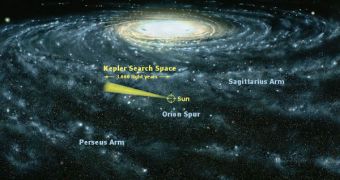Late last night, NASA officials and engineers were on the edge. The new Kepler Telescope mission was about to blast off from the Cape Canaveral Air Force Station, in Florida, the coronation of several years of hard work. At 10:49 pm EST (0349 March 7 GMT), successful lift-off was confirmed. More than half an hour after the launch, the multi-million dollar spacecraft managed to separate from its Delta II rocket and start heading towards a trailing Earth orbit. According to initial telemetric feedback, the telescope is in perfect “health,” and ready to go to work.
The team behind the project says that Kepler is one of the most important missions NASA ever blasted off to space, on account of the fact that it's the first telescope to be designed specifically to discover Earth-like planets in our galactic surroundings.
The entire mission is scheduled to last approximately three and a half years, during which time the Kepler Telescope will orbit the Sun once every 371 days. Everyone at the American space agency is now relieved knowing that the mission was successful, on account of the fact that this is the first launch following the failure recorded by a much-mediated Earth-observing mission, featuring an advanced CO2-tracking satellite. On February 24th, that launch failed, and the CO2 monitor ended up at the bottom of the ocean.
“Today's launch was the second for NASA aboard a Delta 2 in just 28 days, coming on the heels of the successful NOAA-N Prime launch Feb. 6. The NASA/ULA Delta 2 partnership has launched many important scientific missions directly benefiting everyone here on Earth. Launching these two missions for NASA has been a wonderful way to celebrate the program's 20th anniversary,” said the vice president of the United Launch Alliance, Jim Sponnick, following the success.
“It was a stunning launch. Our team is thrilled to be a part of something so meaningful to the human race – Kepler will help us understand if our Earth is unique or if others like it are out there,” said the Kepler project manager, Jim Fanson, working at the Jet Propulsion Laboratory in Pasadena, California. Over the next two months, his team will conduct calibration work, to ensure that the craft is ready to use.

 14 DAY TRIAL //
14 DAY TRIAL //